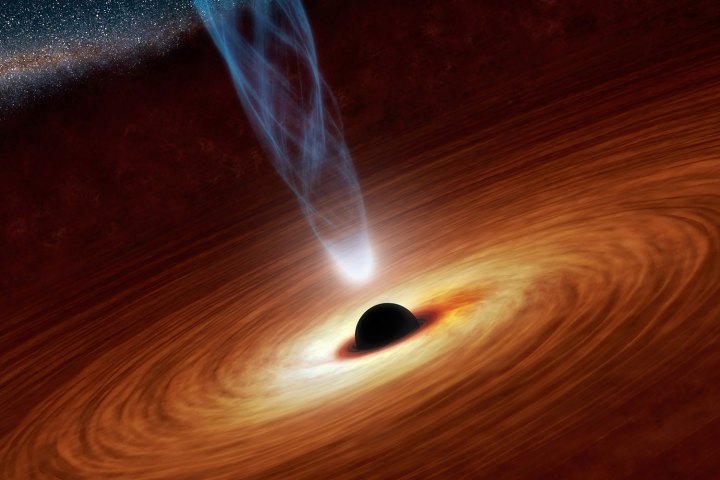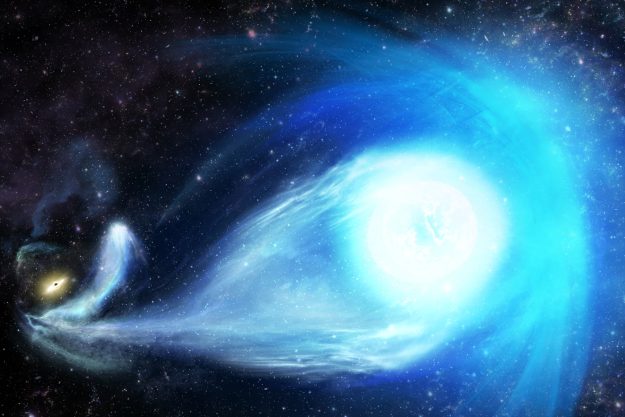
In a stroke of strange inspiration, University of Surrey Ph.D. student Miklos Peuten and professor Mark Gieles created a computer simulation of the globular cluster NGC 6101, inserted hundreds of black holes, and let the program reenact the star system’s 13 billion-year history. What they discovered made sense of its physical dynamics — but undermined conventional wisdom about how black holes and globular clusters develop. The researchers published their findings last week in the journal Royal Astronomical Society.
Black holes are impossible to observe directly but astronomers can detect their effect on things around them.
“We know today that many black holes are created in globular clusters,” Peuten told Digital Trends. “But up until now, the thought was that if a black hole was created in a globular cluster, it would normally get kicked out during a supernova kick — the explosion of a massive star. In the end, there are just a couple handfuls of black holes retained but those black holes eject each other quite quickly, so in the end, the cluster is left with at least one [black hole].”
In the past few years, some studies suggested that when black holes are retained within a globular cluster, they tend to sink into its center, creating the visual impression that the cluster is puffed up because all the observable stars are located towards the outside. NGC 6101 has this inflated appearance and unusual distribution, with few observable stars at its center. “So we decided to try adding a bunch of black holes to a simulation,” Peuten said.
Black holes are impossible to observe directly but astronomers can detect them by measuring their effect on things around them. They devour clouds of gas, tear apart massive stars, and emit gamma-ray bursts, the brightest events in the universe. But, if black holes aren’t obviously interfering with interstellar events, astronomers have no way of knowing they’re there.
So they often have to use their imaginations — running cosmological computer simulations to see whether a black hole here or there can make sense of a system’s structure and dynamics.
Peuten and Gieles created three simulations using a program developed by renowned Cambridge astronomer, Sverre Aarseth. They first recreated NGC 6101 without any black holes. They then recreated the cluster as it might appear if 50 percent of its black holes were ejected. Finally, they ran a simulation that depicted the cluster as if it had retained all of its black holes during its lifetime.
It took one month to run each 13 billion-year simulation.
“When we compared the results, we found that the simulation without black holes couldn’t recreate what we see in NGC 6101,” Peuten said. “Meanwhile, the one in which all the black holes are retained almost perfectly matched up with what we see [in the sky].” The simulation which kept 50 percent of the black holes also failed to depict the cluster accurately.
“We’ve detected that merging black holes exist through their gravitational waves ripples”
If Peuten and Gieles’s discovery holds true, two commonly held astrophysical assumptions may be overturned. For one, supernova kicks must be much less powerful than previously thought and, as such, globular clusters may contain many more black holes, meaning they impart a more observable — albeit subtle — effect on the dynamics of the system.
The simulation may also shed light on this year’s landmark detection of gravitational waves — ripples in spacetime which are emitted when two black holes merge. “We’ve detected that merging black holes exist through their gravitational waves ripples,” Peuten continued. “The questions is now, ‘Where are they?’”
If NGC 6101 does contain hundreds of black holes, many of these black holes will someday merge and emit gravitational waves. If other globular clusters contain as many black holes, astronomers could make more targeted studies, searching for signs of these waves within the clusters themselves to pinpoint their location.
“Knowing now that they can exist in these clusters and knowing some of their properties, we can make studies to find out how they merge and how to further help the gravitational wave scientists tune their instruments to detect these kinds of events,” added Peuten.
Peuten is audibly excited about the discovery but he admits that the data on NGC 6101 is not perfect. “The technique we used had to entail some simplification,” he pointed out. For example, he can say that hundreds of black holes probably exist in NGC 6101 but he can’t give a precise number. “Also there’s the problem that we don’t 100 percent know the average mass of these black holes.”
In their ongoing research, Peuten and Gieles plan to examine alternative theories, such as one which suggests a hypothetical “intermediate-mass” black hole is the cause of the cluster’s shape. They’ll also simulate other similar clusters and determine if a number of black holes will make their structures and dynamics come together.
In the end, Peuten asks questions which mirror the form of the greatest scientific inquiries. “Is this cluster a normal case?” he asks. “Or is it completely unique?”
Editors' Recommendations
- They shot the world’s first black hole photo. Now they’re shooting a video
- Astronomers want your help to identify thousands of black holes
- Hubble images dusty galaxy to learn about supermassive black holes
- Astronomers explain what fed hungry supermassive black holes at dawn of universe
- Planets could form around supermassive black holes, new study shows



